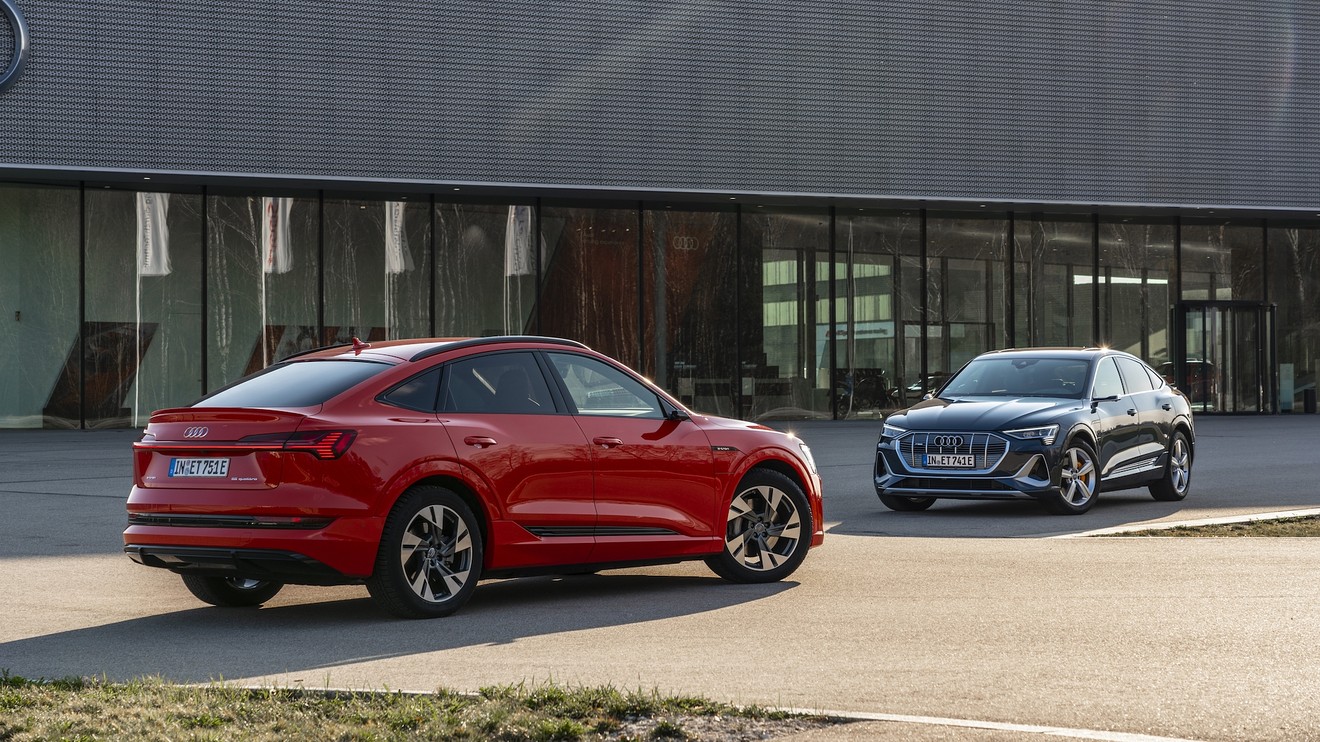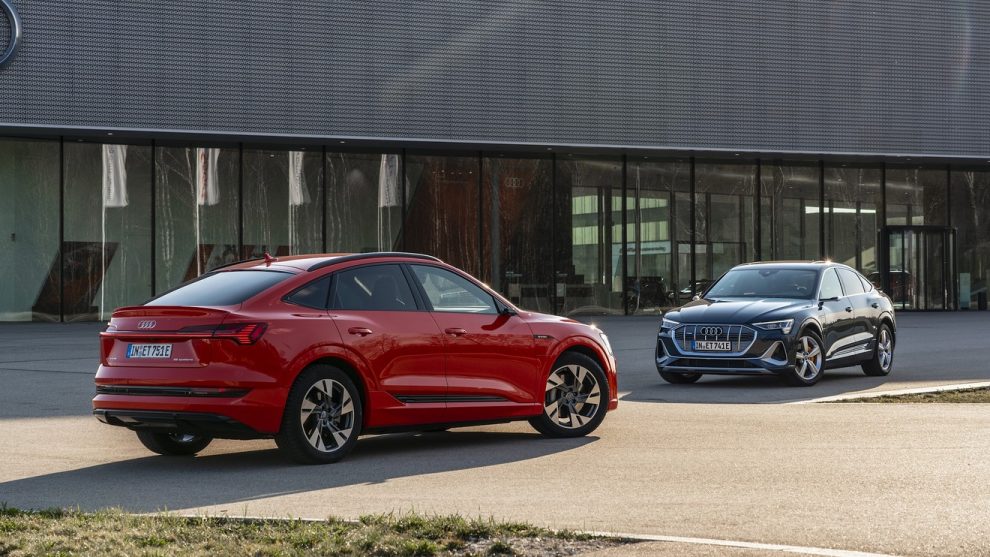
Until the recent acquisition of an Audi e-tron, our family couldn’t find an EV that fit our needs. Like most American families, we’ve had a midsize crossover SUV stealing space in our garage for more than a decade. It’s easy to get used to all that interior volume. In our case, the slightly taller design allows for easier loading and unloading of kids and car seats into the back seat.
The competition
The Tesla Model X and Jaguar iPace were both on our radar. However, we wanted something with more room than the Jag. And we could do without the flashiness of the Tesla TSLA, -10.34% . The Audi e-tron seemed ideal. The handsome design of the e-tron echoes other Audi crossovers without looking too futuristic. It’s also the perfect size, only slightly larger than the Q5 we used to own but much roomier on the inside, particularly in the back seat. Like most Audis today, the interior is modern, plush, and dressed in beautiful materials.
See: What it’s like to drive a Tesla Model Y
It might sound strange, but electric driving range was less critical for our family. Most of the time, the vehicle would be driven 30 to 50 miles a day. We have a secondary gas vehicle that can handle long family road trips. So the 204-mile EPA range is plenty.
The drive
Our $87,025 Siam Beige Prestige e-tron arrived in July wearing 21-inch wheels and just about every option, including the towing package ($650), cold weather package ($900), and rear side thorax airbags ($400). First impressions? I was surprised at how well the car rode, considering the low profile 21-inch tires. It’s smoother than our old Q5 as well as the Mercedes GLC 300 we recently leased, and the e-tron’s overall structure feels robust, even when driven through a field of potholes. The interior is forward-looking and techy but easy to navigate too. The overall experience is more A8 than Q5 in terms of the quality of the furnishings and the serenity of the drive experience.
The e-tron is reasonably quick. It handles nicely in Dynamic driving mode, with the air suspension lowered down. Even in that more aggressive vehicle setting, the e-tron’s suspension is compliant. But honestly, we rarely push the handling limits of the e-tron. This car spends most of its time in Efficiency mode plodding along relatively straight and uninteresting roads – commuting, fetching kids and running errands.
Road tripping
We’ve taken the e-tron on a few road trips and it’s been an excellent companion. However, on one weekend trip to Legoland California, we ran out of space. The e-tron’s cargo hold swallowed all the luggage for our family of four but didn’t quite have enough room for our stroller too. So, we had to rent one each day from Legoland. Not a huge deal, but we’d welcome more cargo capacity on a future model.
Legoland’s resort has 16-amp 240V charging stations available, which we used. But to fully recharge our half-depleted pack, it required more than an overnight.
On that trip, we all noticed how exceptionally quiet and isolated from the world this Audi is, more so than other EVs we’ve tested. Our kids fall asleep quicker and easier in this Audi than any vehicle we’ve ever owned. If you have young kids—you know that’s important.
See: These are the best cars for families in 2020
In terms of EV range, on relatively flat routes, we’ve found the e-tron’s EPA rating of just over 200 miles to be a little conservative. On one trip, we drove the Audi from Los Angeles to Santa Barbara for a weekend. And we didn’t re-charge until we returned home. The car traveled 220.6 miles on a full charge over the mostly freeway route.
Turtle mode
Interestingly, the e-tron warns you of a “low” battery at around 60 miles remaining, then again at 30 miles. When you reach 10 miles or less, it flashes “Drive System Warning! Limited Performance” and shows a tiny bright yellow turtle. Cute. That mode feels like a hyper-restrictive Efficiency mode when you push down on the accelerator. At that point in the trip, we engaged the car’s Range Mode, which added 9 miles to our battery by dialing back the air conditioner and ventilated seats. But unlike some relatively pedestrian EVs we’ve driven, the e-tron doesn’t automatically search and suggest public charging stations nearby when the battery gets critically low, which was a little surprising.
On our way home, we took a downhill canyon route, which put some range back into the battery pack thanks to the car’s regenerative braking. You can dial in more regen temporarily by tapping a paddle shifter on the steering wheel. Or you can set the regen level manually through the infotainment system. But on this trip, we let the Audi’s default mode decide how much to use. By the time we reached the Pacific Coast Highway at the bottom, we had put 4 miles back into the pack. Not bad.
Read: A plug-in hybrid Jeep is coming. Check out the Wrangler 4xe
On that trip, we averaged 4.3 km per kWh according to the display, which is about 2.7 miles per kWh. In the 1,100 miles we’ve driven the car, we’ve averaged 3.5 km per kWh or about 2.2 miles per kWh.
Charging at home
We decided to buy a ChargePoint 32A home charging station for our garage mainly out of convenience. Yes, we could have used the supplied portable charger that comes with the car. But that would require pulling it out of the e-tron’s “frunk” every time we needed a charge. And since we needed to wire our garage for 240V anyway, it made sense to permanently mount a Level 2 charger. The sleek design of the ChargePoint charger appealed to us more than other home chargers we cross-shopped. And it works great. A nearly depleted battery will fully charge about 13 hours. The downside? It cost over $500, not including the installation.
The ChargePoint app is easy to set up so we can monitor charging from our phones, turning it on and off as well as schedule charging at off-peak times when rates are lowest. You can also see an estimate of how many miles have been added while charging and how much it cost for the charge. Audi’s own app also monitors and allows you to plan charging as well as perform many functions like locking and unlocking your doors, setting stationary climate control, and locating the e-tron should it be stolen.
Also see: 8 new luxury SUVs for under $50,000
Volkswagen VWAGY, -1.58% and Audi have a partnership with Electrify America 150 kW DC fast charging, which is exciting. We can’t wait until the network is fully developed with charging stations to allow longer interstate road trips. The app is downloaded on our phones, but we haven’t needed to use one of the stations yet. If you’re thinking three apps for one car seems like two too many, well, we kind of agree.
Good and bad
There’s a lot to love about the e-tron. But there are also a few things that could use some improvement. The steering wheel tilts and telescopes, but it’s not quite enough. Both my wife and I want more range of adjustment, and we’re two very differently sized people.
See: Thinking about an EV? Here are the 6 best in 2020
Though the shifter is handsome, it’s a little awkward to use, and it doesn’t like to be shifted quickly from Park to Drive. Your foot needs to be pressing with enough pressure on the brake pedal to allow shifting, more than most gas cars. The tiny Park button on the end of the shifter can be tough to find sometimes. In Drive, the e-tron will roll backward on the gentlest slope as soon as you lift your foot from the brake. You expect the vehicle to provide some resistance and hold you there as a gas car would, but it doesn’t. Oddly, there is a hill holder function but it releases too quickly when you lift your foot from the brake.
Also see: Toyota brings back the Venza as a hybrid only, and it has a lot going for it
In terms of the car’s electronics, we like most of the systems – and we love the functionality of the touch screen. However, it would be helpful to be able to tune the safety systems to our preferences a bit more. The cross-traffic alert, which we rely upon on our tightly-packed street, does not warn you quickly and aggressively enough if traffic is crossing behind the car. On the contrary, the parking sensors are highly sensitive and very loud. Pulling into our garage every day is accompanied by a symphony of long, sustained beeps, even though we have plenty of space. That said, the 360-degree view camera we’ve found to be helpful when negotiating tight, unfamiliar spots.
Conclusion
Those are small critiques of an otherwise incredibly comfortable, luxurious, and smart EV. We’ve just begun our adventure with this car, but we’re happy so far. If given the choice would we choose the e-tron again? Absolutely.
This story originally ran on KBB.com.











Add Comment